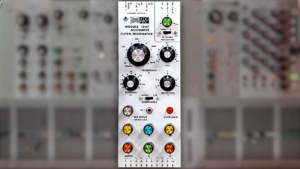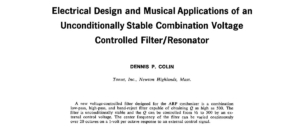The ARP Module 1047 Multimode Filter/Resonator
by Chris Meyer of LearningModular.com
The ARP Module 1047 Multimode Filter/Resonator introduced several significant features to the modular synthesizer landscape in 1970, including:
- It was one of the very first multimode filters (along with the EML Electrocomp 100), offering four different filter output responses simultaneously, with a particularly interesting Notch response.
- Its bandpass output had a gentle 6 decibels/octave slope on either side of its voltage-controllable “corner” frequency, making it ideal for replicating acoustic resonators. At the other extreme, it could be set to a very high “Q” or feedback, allowing only a very narrow band of frequencies to get through.
- It could act as a percussion module, with a dedicated input for a gate or trigger signal to “ring” its filter, with adjustable decay.
Let’s dive in a bit deeper into what made this filter unique.
The 1047 had simultaneous low pass, high pass, band pass, and notch outputs. Particularly interesting is the notch filter, as it provided a substantial 40 decibels of rejection, plus the ability to offset that notch from the filter’s normal corner frequency (Fc). When Resonance (feedback or Q) was turned up, this meant the 1047 emphasized harmonics at the corner frequency, and cut them at the notch’s offset frequency. Some modern modular filters recreate this by using two or more independent filter elements.
The primary method at the time to create a band pass filter at the time was to “couple” together a low pass and a high pass filter. This is seen in the Moog 904A/B/C module combination (low pass, high pass, and coupler), and the Buchla Model 191 Sharp Cutoff Filter. These filters had steep 24 decibel per octave slopes, meaning harmonics above or below the corner frequency were quickly attenuated. That steepness was not ideal for simulating acoustic instruments and spaces.
The 1047 featured a more gentle and realistic 6 decibel per octave slope, which made it better suited for creating sounds that reference acoustic resonators such as a pipe or the body of a violin or guitar. Indeed, a common patch on the 2500 was to send an oscillator’s signal through both the Module 1066 Low Pass Filter and the 1047 in series, to combine a typical enveloped-filter synthesizer sound with a natural resonator effect.
The 1047 also had the option to dial in much higher resonance than other filters of the time, narrowing its band pass response to be as narrow as 1/32 of a semitone. This meant it could be used to pick out individual harmonics in a sound. Combined with its external audio input, it could even be used as a piece of precision audio test and analysis equipment! Indeed, its creator Dennis Colin noted that its circuit was evolved from a design used in analog computers at the time.
Another interesting feature is the 1047’s “Keyboard Percussion” input. A trigger or gate signal that signified the start of a note could be patched directly into the 1047, causing the filter to oscillate briefly in its own. The bandpass output was preferred for this application. The duration or decay time of this oscillation was set by its Resonance control, and it could be tuned with the Frequency control.
Most analog drum machines of both yesterday and today use this ringing filter trick to create their “shell”-based sounds such as kick drums and tom-toms. You will also see some modern modular filters with dedicated “ping” inputs to replicate this effect.
The Module 1047 Multimode Filter/Resonator was so significant at the time that Dennis Colin presented a paper on it at the 1971 Audio Engineering Society (AES) conference, which was later reprinted in the Journal of the Audio Engineering Society.
Advanced synthesists still revere the 1047 today as an example of what a versatile, good-sounding filter should be like.






